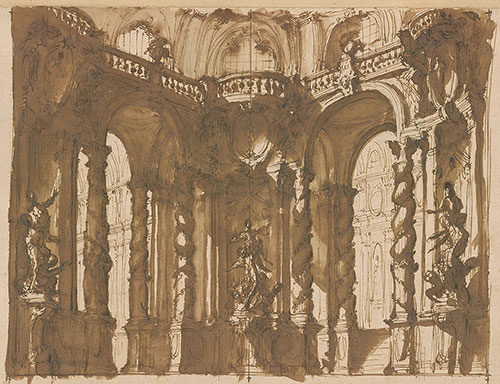
Designing a set for the theater stage presents a unique challenge: How does the artist visually transport live performers into the fictional world of the performance? Relying on a newly understood system of linear perspective, Italian Renaissance set designers created the illusion of a three-dimensional space projecting beyond the backdrop and receding toward a fixed point on the horizon, producing a window onto a symmetrical world in which the narrative unfolds. Later scenographers continued to employ this perspectival system, though they produced increasingly elaborate designs and special effects.
From the late seventeenth through the eighteenth century, the Bibiena family pioneered and popularized a different solution. As showcased in Architecture, Theater, and Fantasy: Bibiena Drawings from the Jules Fisher Collection, the family’s innovation was the scena per angolo, or “scene viewed at an angle,” which used multiple vanishing points beyond either wing of the stage. This development created the potential for seemingly boundless architecture.
The Bibienas were followed by later scenographic families, such as the Quaglios and Galliaris, who similarly worked across Europe for generations. The works shown here, offering a brief overview of European stage design from the Renaissance to the nineteenth century, pull from the Morgan’s immense collection of theater drawings.
Filippo Juvarra (1678–1736), Hall in a Royal Palace, ca. 1708–14. Pen and brown ink, with brown wash, over graphite; 203 x 266 mm. Bequest of Mrs. Donald M. Oenslager.
